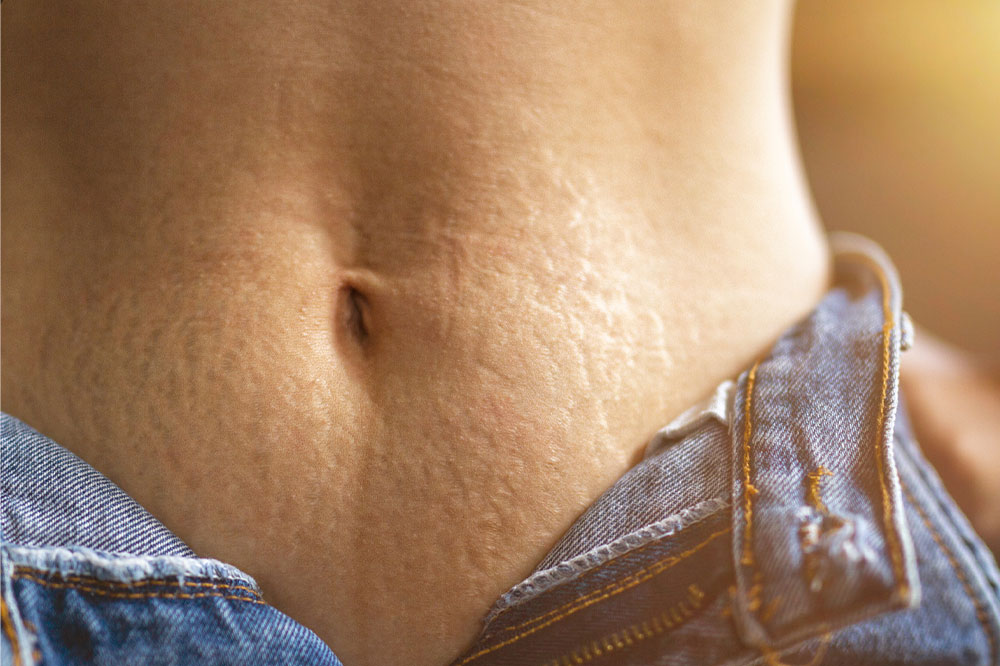
Stretch marks – Causes, remedies, and prevention
Stretch marks, also known as striae, can affect people of all ages. These long, narrow streaks or lines on the skin can appear on various body parts, such as the abdomen, thighs, hips, breasts, and arms. While stretch marks are generally harmless and do not pose any health risks, they can be a source of self-consciousness for some individuals. Here we’ll explore the causes of stretch marks, remedies for reducing them, and essential tips for preventing them.
Causes of stretch marks
Rapid growth
Adolescents experiencing growth spurts and pregnant women are susceptible to stretch marks as the skin rapidly stretches to accommodate changes in body size.
Pregnancy
During pregnancy, the skin on the abdomen and breasts undergo significant stretching, leading to stretch marks commonly known as ‘pregnancy stretch marks.’
Hormonal changes
Stretch marks can develop due to hormonal imbalances, which may occur during puberty or due to certain medical conditions.
Genetics
An individual’s likelihood of developing stretch marks can also be influenced by their genetic makeup.
Remedies for reducing stretch marks
Creams and oils
The texture and appearance of stretch marks can gradually improve with the regular use of creams and oils containing ingredients such as retinoids, hyaluronic acid, and vitamin E.
Laser therapy
Stretch marks can be improved by laser treatments like fractional laser therapy and pulsed dye laser, which stimulate collagen production and enhance their color and texture.
Microneedling
This technique involves using small needles to create controlled micro-injuries in the skin. This process triggers collagen production, which can help to reduce the appearance of stretch marks.
Chemical peels
Exfoliating the skin with chemical peels can promote the growth of healthier skin cells and potentially improve the appearance of stretch marks.
Stretch marks removal products
Several products claim to remove stretch marks, but it’s essential to approach these claims with caution. While some products may help improve the appearance of stretch marks, a complete removal is unlikely. Look for products containing nourishing ingredients like shea butter, cocoa butter, and vitamin E, which can moisturize and hydrate the skin, enhancing its elasticity.
Stretch marks prevention
Hydration
To prevent stretch marks, it’s important to keep the skin hydrated. One way to do this is by drinking plenty of water, which helps maintain skin elasticity.
Balanced meal plan
One must also follow a meal plan rich in vitamins A, C, D, and E, as well as zinc and protein. This will help improve one’s skin health.
Moisturize
To prevent stretch marks, it’s recommended to apply moisturizers and oils to the skin regularly. This will help keep the skin supple and less prone to developing stretch marks.
Gentle exfoliation
To promote skin regeneration, it’s recommended to gently exfoliate the skin to remove dead skin cells.
Although it may not be possible to remove stretch marks completely, several remedies and treatments can help reduce their appearance. Creams, laser therapy, microneedling, and chemical peels are some options. It’s important to choose products with nourishing ingredients that will improve skin health when looking for stretch mark removal solutions. In addition, practicing stretch mark prevention by following a balanced meal plan, staying hydrated, and following a gentle skincare routine can help maintain skin elasticity and reduce the likelihood of developing new stretch marks.




